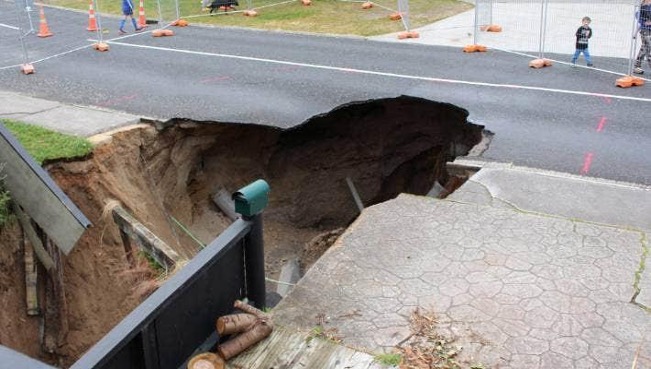Subsidence
Subsidence occurs when earth and rock fall into a cavity that has formed below the ground’s surface. It is a natural process, although it can also occur as a result of people’s activities (for example, landfills and mining).
Natural subsidence is not widespread in the Waikato region, although it is sometimes seen in the Waitomo District and in Taupō District. Subsidence can also occur where there is thermal power generation or mining activities. For example, in December 2001, 16 houses in Waihī had to be evacuated after old mine workings collapsed beneath them without warning. (Waihī subsidence assessment, GNS Science, 2008)
What causes subsidence
Ground stability is a characteristic of the interaction between water, soil and the underlying geology. Different soils react in different ways to the presence or absence of groundwater. The effects of subsidence can also be accelerated or triggered by other natural activity in the area, such as tectonic activity, earthquakes and groundwater variations.
Waitomo’s landscape is mainly formed from limestone with underground drainage and many cavities and passages. This type of landform, known as ‘karst’, features many sinkholes or ‘tomo’. Tomo are formed when groundwater dissolves underlying limestone rock. The dissolved hole enlarges to a point where it can’t support the ground above it. Rubble falls into the hole initially supporting overlying material, but leaves a visible ‘slump’ on the surface. Water erodes the supporting material so that eventually the overlying material also falls away leaving a hole.
Subsidence can also be caused by the burst of underground infrastructure, especially water pipes, releasing a large amount of water and causing soft soil material to liquefy. Below are a few examples from the Taupō area.
 In August 2018 a burst water main caused a sinkhole on Arrowsmith Avenue, Taupō (source: Stuff)
In August 2018 a burst water main caused a sinkhole on Arrowsmith Avenue, Taupō (source: Stuff)
 In July 2019 a burst pipe caused road subsidence of the road and a wastewater spill into lake Taupo (source: NZ Herald)
In July 2019 a burst pipe caused road subsidence of the road and a wastewater spill into lake Taupo (source: NZ Herald)
Managing subsidence
As a natural hazard, the early signs of subsidence are not always visible before a major slump occurs. We need to identify and monitor areas at risk to avoid any threat to people’s lives and property due to subsidence.
